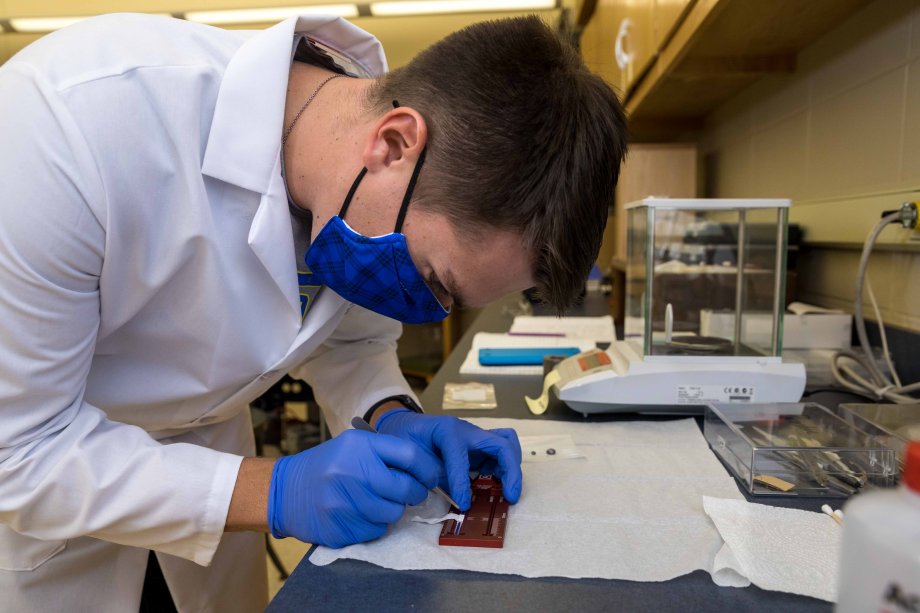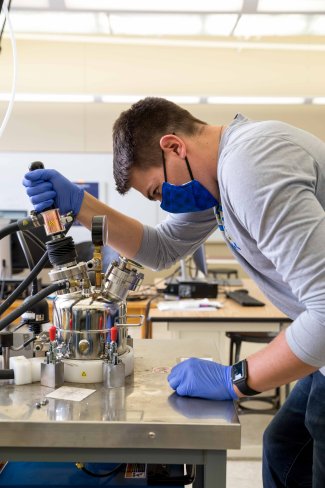
When Sioux Falls native Zachary Lehmann came to South Dakota State University, he set his sights on becoming a medical physicist.
“In AP physics class (at Washington High School), I was exposed to the field of medical and health physics, such as radiation therapies for cancer. That piqued my interest (in medical physics),” Lehmann said. “SDSU offers a health physics emphasis and biochemistry fit in with that.”
However, it has been Lehmann’s experiences with research at SDSU and the Mayo Clinic that helped refine his career path.
During his second semester at State, associate physics professor Parashu Kharel offered Lehmann an opportunity to do research on semiconductor materials. That experience helped him get a Summer Undergraduate Research Fellowship in molecular pharmacology at Mayo Clinic. As a member of the Van D. and Barbara B. Fishback Honors College, Lehmann is doing his senior research project on wound recovery and the lymphatic system under the tutelage of assistant professor Darci Fink in the chemistry and biochemistry department.
Through these experiences, Lehmann, who graduates in May, has decided to pursue a doctorate in biophysics and structural biology. He has applied to well-known research institutions, such as Harvard, Princeton, Duke and Vanderbilt, and will find out this spring which university he will attend.
Lehmann’s advice to other undergraduates is simple: “You have to be willing to try everything to find out what you like.”
Learning research skills

“Zach not only has the academic talent to solve problems, but also has people skills to work with patients and doctors to deliver better solutions,” said associate professor and assistant department head Rob McTaggart, who coordinates the medical and health physics emphasis. The multidisciplinary emphasis supports students going into medical school or graduate work in biomedical engineering or becoming a research scientist at a hospital or national laboratory working with radiation therapy, medical imagery and nuclear medicine.
“Undergraduate research requires commitment and motivation to put in the time and effort to do productive research,” Kharel said. “Zach is a highly motivated student and has become an independent researcher. For my (materials) lab, he is like a graduate student.”
Though physics is solely an undergraduate program, Kharel makes publishing a priority in his research lab. “We work as a group, preparing the first draft and then keep revising until it is ready for submission,” he said. Lehmann is second author on an article published in AIP Advance and on an article recently accepted for publication in the Journal of Alloys and Compounds. “By the time Zach graduates, he may be able to publish one more paper from his work.”
In addition, Lehmann presented research at a national conference in 2021, which was virtual due to the pandemic, and his abstract has been accepted to present at the March 2022 American Physics Society Conference in Chicago.
“I also encourage my students to go beyond my lab, so they can network and learn new research techniques,” Kharel said. Lehmann’s plans to go into the biomedical field led him to look at summer research opportunities at health care institutions.
Gaining insight at Mayo
“My research experiences with Dr. Kharel were the biggest highlights on my Mayo Clinic application,” said Lehmann, noting he later found out he was the only applicant who had published a research paper.
“Though the (physics) research does not have a lot to do with pharmacology, a lot of the soft skills you develop—notetaking, lab techniques and safety, data keeping and presenting and communicating science in that technical context—make you good in other research settings,” he said.
Lehmann received the fellowship in summer 2020, but the program was canceled due to the pandemic. After consulting with the molecular pharmacology group’s lead scientist, Lehmann reapplied and secured the same position for summer 2021.
At Mayo, Lehmann developed a computer program that identifies gene regulatory networks, extrapolating the transcription information from an RNA sequence dataset. “Most of the other students were biology majors, but I had a unique research skillset that a lot of them were lacking,” he said. By understanding the genetic mechanisms that differentiate cells, Mayo researchers hope to be able to push cells into specific types, particularly immune cells for use in cancer therapeutics.
“My experience at Mayo Clinic showed me I want to do biological research applied to health care,” Lehmann said. However, he saw the need to gain a better background in biology and solving biological problems.
That led him to take on another research position with Fink, who studies lymphatic vessels using transgenic mouse models and advanced microscopy. There Lehmann is using cornea tissue from mice to examine how the lymphatic system is constructed and deconstructed during wound recovery. To do this, he captures images of tissues using two-photon microscopy.
“One of Zach’s biggest strengths is that he wants to understand the background of the experiments deeply. He wants to know how everything works and why we are doing it the way we are. Approaching research with this mindset at this stage of his career is impressive. That will be a real asset as he learns to investigate on his own,” Fink said.
Republishing
You may republish SDSU News Center articles for free, online or in print. Questions? Contact us at sdsu.news@sdstate.edu or 605-688-6161.

